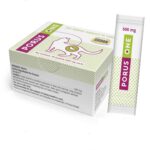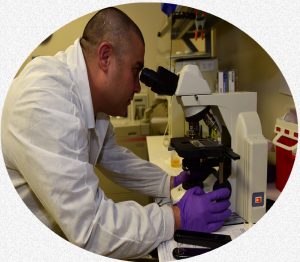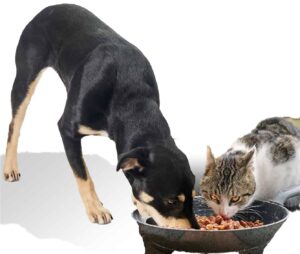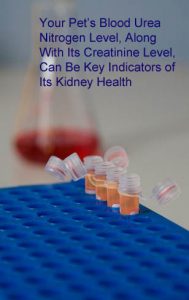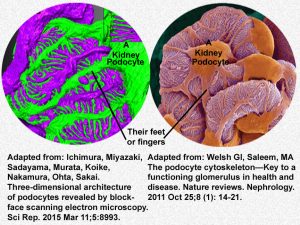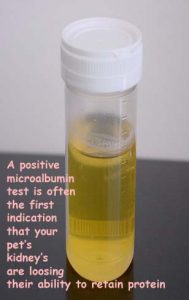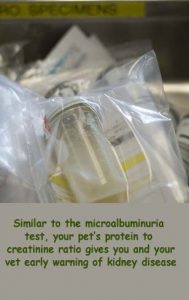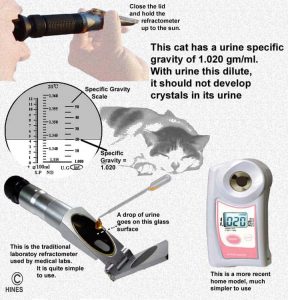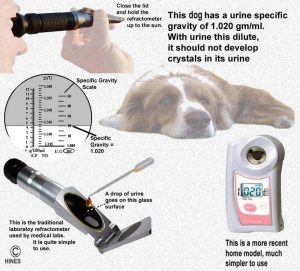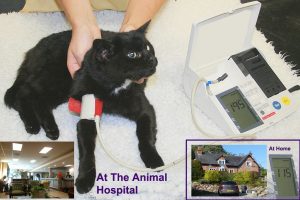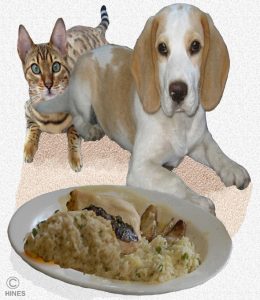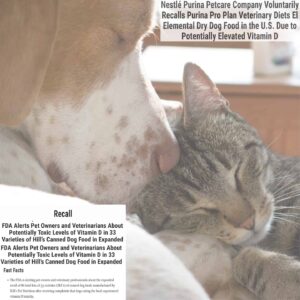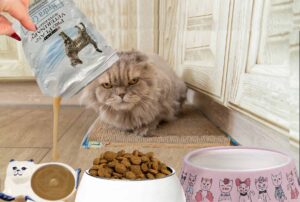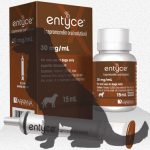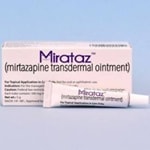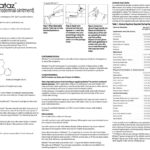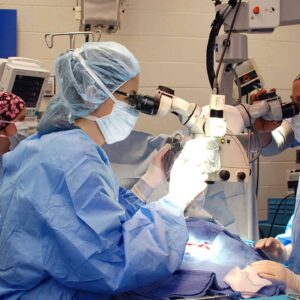Chronic Kidney Disease In Your Cat Or Your Dog – CKD – Current Diagnosis And Treatment
Ron Hines DVM PhD




There was a time when infectious diseases were the leading cause of mortality in our dogs and cats. We have good, long-lasting vaccines now, so those times have passed. Today, chronic kidney disease (CKD) leading to kidney failure is near the top of the list as the cause of death in older pets. Just behind the #1 and #2 causes in dogs – cancer and heart disease – and probably ahead of heart disease in cats.
For the vast majority of our pets, kidney failure is a disease of old age – the wear and tear of time. By the time a dog reaches ten years of age, about 20% show laboratory evidence that their kidneys have lost some of their capacity to cleanse their bodies. The larger the breed, the more rapid that decline is likely to occur. In 10-year-old cats, those chances are even higher. By the time cats reach the age of 15, most of them have some loss of kidney function. Veterinarians used to call this progressive glomerulosclerosis. Today we call it CKD (chronic kidney disease = CRD = chronic renal disease = chronic tubulo-interstial nephritis). All are synonyms for that slow, relentless, age-related inflammation that gradually destroys a pet’s individual kidney filter units, the nephrons. You might notice that the less doctors understand about a health problem that frustrates them, the more complicated multiple names they tend to give it.
Old age brings multiple health issues to all of us. But only some of our cats and dogs will reach the point of actual kidney failure. For many, unrelated health issues will cause them to pass away before that occurs. (read here) All the organs of your dog and cat’s body have to work in unison to keep each other functioning well. So, although you may have been told that your pet died of heart failure, or perhaps and infection, its kidney issues may have contributed to its demise. (read here & here)
God generously gave all mammals considerably more of those nephron filter units than required. Us humans have about 1 million nephron filtering units in each of our kidneys. (read here) No one I know of has estimated their number in dogs or in cats. With every heartbeat, about 20-25% of your dog and cat’s heart volume of blood is sent through your pet’s kidneys for cleansing, fluid regulation and blood ion adjustments. Kidneys must work very hard.
Do Veterinarians Know Much More About Why The Kidneys Of Elderly Cats And Dogs Fail, And How To Delay And Deal With That, Than They Did 20 Years Ago?
Not really.
The only illuminating dog and cat studies were those performed by Dr. Delmar Finco and Dr. Scott Brown in the early 1990s. (read here, here, & Finco1999). They were independently minded veterinarians at the veterinary school at the University of Georgia. You can ask me for their complete articles. Dr. Brown once mentioned to me that those studies’ main revelation was that in advanced kidney failure, a lower phosphorus diet prolonged life. For humane reasons, studies that would confirm those results in cats or dogs, or lead to more effective medication options, can no longer be performed in the Western world. They involved removing the majority of an animal’s kidneys, and would be considered too cruel to perform today. Most, more current veterinary studies don’t pass muster because they have too many multiple confounding variables to make much sense of their results. (read here) Or, they rely on too few animals to support the broad conclusions drawn to be statistically valid. Or companies with lucrative products to sell to you underwrote the cost of the studies – never a good situation for unbiased conclusions. The internet, eBay and Amazon are full of worthless “kidney cure” products – all presented with glowing testimonials, five-star ratings and a lot of impressive gobbledegook “science” to back them up.
So Dr. Finco and Dr. Brown’s studies are still the basis for all the recipes of the name brand “kidney health” diets veterinarians and retailers sell today. Purina Cat Chow Complete Dry is 32% minimum protein, 12% minimum fat and 0.9% minimum phosphorus, while their NF Early kidney care diet is 33% minimum protein, 13% minimum fat and 0.55% maximum phosphorus. Their advanced CKD diet is 26.5% protein, 16% minimum fat and a maximum of 0.44% phosphorus. Hills Science Diet Adult Cat dry diet is 30% crude protein minimum, 17% crude fat minimum. Phosphorus is not given. Hills Feline KD CKD dry diet is 20-26% protein, a minimum of 4% fat, and 0.3-0.75% phosphorus. Their Hills Science brand adult canine dry has a minimum of 20% protein, 12.5% fat. Hills KD CKD canine diet has a minimum protein content of 12%. minimum fat content of 17.5% and a maximum of 0.55% phosphorus. These labels are designed to confuse. Minimums without maximums and crude protein levels mean little. Chicken feathers are about 84% crude protein. However, they are not digestible. There is no data one way or the other to tell us if pets begun on these diets before their blood phosphorus level rises increases their lifespan. As for the rest of the extra ingredients in these “kidney care” products, there is no quality science or explanations as to why any of them would affect your pet’s kidney health one way or the other.
So, today, why the kidneys of old dogs and old cats commonly fail remains a mystery. And when you don’t understand why something unwanted happens, it is hard to plan an effective response. There are oodles of theories. All are unproven. Veterinarians do not know whether there is one major cause or many causes. We also know very little about the dynamic events (real-time processes) occurring in your pet’s kidneys that lead to their eventual failure. What we do know is that by the time kidneys do fail, they all look pretty much alike when viewed under the pathologist’s microscope. The glomeruli (the numerous small kidney filters whose job it is to cleanse your pet’s blood) are scarred to the point that they no longer work and there is usually evidence of chronic inflammation surrounding them. The term for that scarring is glomerulosclerosis. Microscopically it is unmistakable. It is also irreversible, and pathologists who view those slides call them no more than the “end stage wreckage” of what were once healthy kidneys.
As I alluded to, that when Science collides with the opportunity to make money, science is rarely the winner. (read here) It’s not that money is not out there to run well-designed unbiased studies that would help your pet and your veterinarian. Colgate-Palmolive, the parent company of Hills Prescription diets, had revenues of 17.967 Billion dollars in 2022 with ~1,997 million spent on advertising and zero dollars devoted to studies where money did not change hands. Industries never toss the dice or go exploring when uncertain outcomes are possible. Here is another example of this pervasive problem:
IRIS
The veterinary International Renal Interest Society (IRIS) periodically produces kidney disease treatment guidelines for dogs and cats. Unfortunately, suggested time points at which medications need to begin, which ones are likely to help, which are not and at what doses they should be used at are all speculative. That same speculation applies to their nutritional guidelines. As to who funds IRIS, quoting from their UK 2022 Financial Statement for 2022 #10213173, “The directors of the company have elected not to include a copy of their income and expenditure account within the financial statements”. However, the directors of IRIS, when they publish in NCBI journals, are forced to disclose if they have received financial support that might influence their reported results. Scanning a number of those articles reveals that many of these directors have accepted money from Royal Canin, Waltham Centre for Pet Nutrition(aka Mars), Hills Pet Nutrition and Nestlé Purina’s Purina Institute. Idexx, the sole manufacturers of their patented SDMA “kidney health” test is among their financial contributors as well. Financial sponsor largesses might be considered admirable by those that receive them – altruism at its finest. But I am suspicious that these “generous” pet food and laboratory test companies are really frenemies, colluding with one another when it is in their financial interest; but never trusting to turn their back one to the other lest they lose some advantage in the lineup. (see here, here & here) Their largesse appears to be second only to their thirst for profit. (see here)
If My Dog Or Cat Has Chronic Kidney Disease, What Signs Might I See?
None of the symptoms of CKD are specific to that disease. All of them could have many other causes. Chronic kidney disease in most dogs and cats develops slowly over years. During the earliest stages, you are unlikely to notice any changes at all in your cat or your dog’s behavior or appearance. That is because, as I mentioned earlier, the kidneys of dogs, cats and us have large, built-in reserves – many more individual filtering units (=nephrons) than are required to cleanse the blood. Like all vital organs (liver, spleen, lungs, etc.) toxins and stresses are encountered throughout life, so backups (reserve troops) are part of Nature’s planning.

The next things you might notice in your cat or your dog facing kidney issues is picky eating, weight loss, less energy, less curiosity and more sleep time. Of course, none of that is specific to kidney problems either. Pet owners are often surprised when I point out how much weight their pet has lost since its last visit. They often reply that they thought it just comes with getting old. We are uncertain why dogs with advanced kidney disease lose their appetite, but it is likely due in part to rising levels of metabolic wastes and toxins within their bodies (in doctorspeak: multifactorial metabolic derangements). In us humans, the loss of lean muscle mass due to chronic kidney disease is one of the cardinal (best) indicators of approaching mortality. (read here) So attempting to force your pet to consume a “kidney health” diet it doesn’t like is counterproductive. Elanco has two products on the market that attempt to increase your pet’s appetite, read about Entyce® for dogs here and Elura® for cats here. Let me know how they work for you. That lack of interest in food is often associated with nausea or vomiting as CKD progresses. I’ll get to the medications that might help with that later.
A decrease in grooming activity, particularly in cats, can be another sign of CKD. Of course, many other chronic health issues can be the cause of an unkempt look as well.
In advanced CKD cases, oral ulcers might develop as well. That often leads to a very noticeable breath odor. It is also common for dogs and cats with CKD to have gum (periodontal) disease resulting in a strong breath. That needs to be tended to by your veterinarian – preferably in a low-risk manner. Remember that CKD pets have an increased anesthetic risks. (read here) Whether periodontal disease is a cause or a result of kidney failure is still being debated. But we know that in advanced CKD, pets can no longer keep their blood phosphorus levels in check. High body phosphorus levels lead to loss of bone calcium (= secondary renal hyperparathyroidism). That, in turn, leads to loose teeth, periodontal disease and a strong breath. (read here)
As CKD progresses, pets often become anemic. Symptoms of anemia that you might notice are more rapid breathing, panting, decreased ability to exercise and elevated heart rate. If you examine unpigmented areas of your pet’s gums, tongue and toenails, they might be a slightly lighter pink or bluish in color. The build up of toxic waste products in its blood might explain a part of your dog or cat’s lack of energy. But anemia, when present, causes a lack of energy as well. Your pet’s kidneys have multiple chores. Besides cleansing its blood, normal kidneys manufacture most of its erythropoietin (EPO). EPO is essential for a pet’s bone marrow to produce new red blood cells. Late-stage kidney disease often lowers your pet’s ability to produce EPO, although some continues to be produced in its liver. Picky eating also leads to malnutrition. That in itself can cause anemia – particularly if folic acid, vitamin B-12 and iron are not consumed and absorbed in sufficient quantities.
Statistics
The Royal Veterinary College in London, my favorite veterinary college, reviewed their database on 107,214 dogs treated at British veterinary hospitals over a 2-year period. They made some interesting discoveries: Among dogs diagnosed with CKD, those 12 yrs or older had 5.5 times the chance of having CKD than those between 4–7 yrs. Cocker Spaniels and Cavalier King Charles Spaniels had the highest breed increased odds of developing CKD when compared to mutts. The most frequent signs that motivated the owners of CKD dogs to bring their pets in for an initial examination were vomiting, increased drinking/urination/incontinence, loss of appetite and loss of weight. Halitosis (periodontal disease) vomiting, diarrhea and lethargy were also among the initial complaints. The median survival time from CKD diagnosis forward was 226 days. (read here)
What Tests Will My Veterinarian Run?
The most important four laboratory tests veterinarians have to detect kidney disease are your dog or your cat are its blood creatinine and blood urea nitrogen levels, the specific gravity of your pet’s urine and the presence or absence of albumen protein in your pet’s urine. After Idexx patented their SDMA blood test, the Company began an intensive marketing campaign suggesting that SDMA levels detected kidney problems at an earlier stage than BUN and creatinine did. I find that test quite unreliable because too many non-kidney health issues have the ability to influence the test’s results. Read about that here. It is true that the blood creatinine test is not perfect; but it is still the best straightforward gauge of kidney health that physicians and veterinarians have to offer. Indirectly, your pet’s creatinine level tells us how well its kidney glomeruli are performing (your pet’s GFR).
Your Dog Or Cat’s Blood Creatinine Level
Creatinine is a normal byproduct of your pet’s metabolism. It is a waste product primarily created by normally functioning muscles; although the meat your pet consumes is also a source of creatinine. Creatinine is not the same thing as the creatine that body builders eat. Vigorous exercise also causes minor increases in your pet’s blood creatinine level. Dehydration, such as from vomiting, diarrhea or insufficient water consumption tends to raise blood BUN level more than creatinine level, but dehydration also elevates creatinine to some extent. Muscular large dogs also tend to have moderately higher blood creatinine levels. Certain commonly used antibiotics (such as Clavamox®/Augmentin®) and antacids (such as famotidine and ranitidine) have been known to elevate blood creatinine levels as well. (read here) There is also evidence that the doses of various antibiotics and medications need to be lowered in advanced kidney disease in cats. (read here) Azotemic = uremic
When your pet’s kidneys are functioning properly, they collect the creatinine from its blood and deposit it in its urine for elimination. When blood flow through your pet’s kidneys is decreased, or when the kidney’s tiny filters (glomeruli/nephrons) are damaged, creatinine will build up in your pet’s blood stream. I mentioned earlier that a pet’s normal kidneys have a reserve – a backup supply of filtering units. It’s only when these reserves have been used up that blood creatinine levels will begin to rise. A mild-to-moderate elevation in your pet’s creatinine results mean the most when the same pet’s creatinine level has been monitored periodically over several years, or when other tests such as urine microalbuminuria or a drop in your dog’s early morning urine specific gravity confirm that a kidney issue may be brewing. The creatinine test faces similar issues in cats. (read here) When periodic monitoring consistently determines your pet’s creatinine levels to be in the “high-end normal” range (i.e., 1.4 mg/dl for dogs and 1.6 in cats), I would still be suspicious that a kidney problem is present in its early stages (IRIS Stage 1).
I believe that the sensitivity and significance of the creatinine test could be greatly enhanced if testing laboratories like Antech and Idexx factored in your pet’s breed, age, sex and body weight when reporting back if your pet’s creatinine test should be considered high, normal or low. A perceptive veterinary nephrologist told me that, in her opinion, the testing lab’s creatinine “normals” were too narrow for large dogs and too wide for the small ones. She gave, as an example, that in a Yorkie, a creatinine level of 1.2 mg/dl (=110µmol/L) might be a warning sign of potential kidney issues; whereas a reading of 2 mg/dl (=176.8µmol/L) in a 60-100 pound dog would probably be acceptable.
Many folks are under the impression that it’s the high creatinine and urea (BUN) in pets with CKD that makes their pets feel ill. Actually, those two are probably some of the least toxic of the 90+ known products that build up in the bloodstream of pets experiencing kidney failure. (read here & here) Creatinine and urea are to CKD as smoke is to fire.
Your Dog Or Cat’s BUN = Blood Urea Nitrogen Level
Free ammonia, a combination of nitrogen, hydrogen and oxygen, is a product of protein metabolism – the disassembly and reassembly of amino acids. Free ammonia is toxic. So, your pet’s body links ammonia to much less toxic carbon dioxide to form urea, aka BUN. That occurs primarily in your pet’s liver. (read here) It is then one of the primary jobs of your pet’s kidneys to excrete this waste urea into its urine for elimination. So, the amount of urea nitrogen (BUN) present in your pet’s blood can be an indicator of your pet’s kidney health. However, BUN is more subject to changes (fluctuations) that are not due to kidney disease than your pet’s blood creatinine is. That is because many other factors other than kidney disease contribute to the rise and fall of urea nitrogen/BUN in your dog and cat’s blood. Things such as infections, fever, stress, poor appetite, starvation. Cushing’s disease, intestinal bleeding, dehydration, extensive skin trauma, certain medications such as corticosteroids, or the amount of natural cortisol in your pet’s blood. Liver disease, congestive heart failure, or ketoacidosis can also influence your pet’s BUN test results. That is why your veterinarian is more likely to rely on your pet’s creatinine test results in evaluating its kidney health than on its BUN in deciding the degree of kidney damage present. In a general sense, the two rise and fall together, and it would be highly unlikely that your pet’s blood urea would be normal while creatinine was significantly high. In those cases, elevated microalbuminuria reinforces the suspicion of kidney health issues. However, there are still human nephrologists (kidney doctors) who feel that their patient’s BUN level is a better predictor of approaching mortality than creatinine. (read here)
Tests To Detect Blood Protein Leaking Into Your Pet’s Urine
Those little filtering units, the nephrons, that I mentioned earlier – the ones that are lost to scarring when your pet develops CKD – contain a critical population of cells. They are called podocytes. You can see some in the composite electron microscope images above. These highly specialized cells wrap around the smallest passageways (capillaries) through which blood rushes through each kidney filtering unit in unison with your pet’s heart beat. (read here) Remember, I mentioned that your pet’s heart send ~ 20-25% of its blood through the kidneys with every beat. Blood is also at one of its highest pressures when it courses through these tiny kidney channels. Podocytes have multiple projections or feet. (foot=podo+cyte=cell). They arrange themselves to have small slits between these feet (think of them more as fingers). Processes occurring within the feet and the small gaps between them normally allow excess water, salts, and body wastes such as urea and creatinine to pass through these slits and out into your pet’s urine. When they are healthy, podocytes do not allow blood proteins, lipids (fats) or red or white blood cells to escape into the urine either. These cells can also vary the size of the slits between them and thus control urine volume as well. Podocytes seem to be the ultimate determinants of kidney health. (read here) It is only recently that scientists have become aware of how important they are. Details are still being worked out. (read here) Every medical scientist’s dream is to discover a way to regenerate them. (read here) When podocytes lose their grip on the tiny incoming blood vessels that they cling to (the afferent glomerular arteriole capillaries), they end up flushed away into the pet’s urine. (read here)
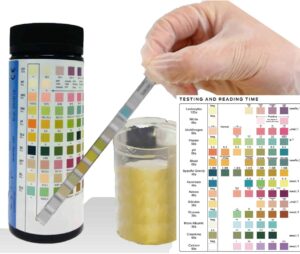
Your Pet’s Urine Microalbuminuria Test
Many corporate animal hospitals run the urine microalbuminuria test in house. I prefer to send them out to a central veterinary laboratory such as VCA’s Antech, Cornell or Idexx. They have deeper pockets than most neighborhood veterinary clinics and a technical staff devoted to equipment accuracy. (read here) They also have the wherewithal to purchase high-end analyzers that I do not have (e.g. Vetscan® VS2 @ $12,235.00 + supplies & Vetscan® HM5 @$16,995.00 + supplies on 4/1/23).
Since healthy kidneys allow very little albumin protein from your pet’s blood to escape into its urine, this test checks for its increased presence without comparing it to the amount of creatinine that is present as the UP:CR test does. The same non-kidney issues I mentioned earlier can also influence your pet’s microalbuminuria results. Some simply refer to this test as an albuminuria test. An albumin level above the upper limits provided is called microalbuminuria positive or just albuminuria+. Some testing laboratories claim that albumin’s presence in elevated amounts in either test will pick up a kidney problem earlier than an abnormally high blood creatinine test. I do not know if that has been verified. However, when either urine protein test is elevated, a complete urinalysis, blood pressure determination, evaluation for heart or inflammatory diseases, diabetes (dog or cat), or hyperthyroidism (in cats) might be in order for your pet.
Your Pet’s Urine P:C Ratio, aka Urine Protein to Creatinine Ratio aka UP:CR
The UP:CR test delivers similar information as the urine microalbuminuria test. It compares the amount of protein present in your pet’s urine to the amount of creatinine present in the same urine sample. That adjusts for the fact that your pet’s urine can be very dilute or very concentrated at different points in the day and in different situations. A low amount of albumin protein in the urine could just mean your dog or cat recently drank a lot. A high amount could just mean that your pet was a bit dehydrated. But the amount of creatinine in urine stays fairly constant throughout the day. One study indicated that dogs with higher UP:CR ratios tended not to live as long as those with lower ratios. (read here) The UP:CR test is still the preferred urine protein test choice of many human nephrologists. But although this is a very important test in identifying early cases of CKD in which your dog or cat’s blood levels of creatinine and BUN have not yet increased or are borderline, there are non-CKD reasons the test might be positive too. Fever, heavy exercise, generalized inflammations, blood in the urine, seizures and various forms of stress occasionally caused urine protein and creatinine levels to rise. Your vet will sort that all out or, perhaps, confirm the results with a second UP:CR test at a later date.
The Phosphorus Level Of Your Pet’s Blood – A Good Indication Of The Seriousness Of The Problem
There is a large amount of phosphorus in your pet’ body and in yours. Bones and teeth hold the largest amount of body phosphorus (~80%). There, it is in the form of hydroxyapatite. The lesser amount of phosphorus is in your pet’s blood and body organs in its ionized form, orthophosphate (~20%). Next to calcium, phosphate is the most abundant mineral in the blood. (read here) Phosphorus moves in and out of your pet’s bones through its blood stream. When there is too much phosphorus present in your pet’s blood, it is its kidneys’ job to excrete the excess into its urine to keep things in balance (homeostasis). Normal kidneys cross-talk (communicate) with bones in deciding how much phosphorus needs to be excreted into the urine. They do so through your pet’s parathyroid glands, small glands in its neck, to keep phosphorus and calcium in its blood stream at optimum levels. This phosphorus regulation process begins to break down when too many of your dog or cat’s kidney nephrons, have been lost to CKD. At that point, the phosphorus level in your pet’s blood will becomes abnormally high (hyperphosphatemia). At the same time, calcium is leached from its bones. Veterinarians believe that high blood phosphorus levels play a significant role in many of the health issues faced by cats and dogs dealing with advanced CKD. Although phosphorus (=P levels) occasionally begin to rise in the earlier stages of CKD, usually P levels go up in tandem with the other tests (BUN, Creatinine & urine protein). Higher than adult normal phosphorus levels are a normal finding in healthy growing puppies and kittens.
The Diluteness Of Your Pet’s Urine – Urine’s Specific Gravity aka SpGr, aka SG
The refractometer in the photo above is an optical device that tells your veterinarian the specific gravity (concentration) of your pet’s urine. The percentage of the sample that is pure water, in relation to the other dissolved elements it contains. The lower the number, the closer the urine is to being distilled water. This reading varies throughout the day depending on the amount of water your pet drinks or any dehydration it experiences. The first urine of the morning is often the most concentrated of the day and gives your vet an indication of your pet’s maximum kidney urine-concentrating ability.
Cats and dogs with progressive kidney disease gradually lose their ability to produce concentrated urine. That is why their, now-dilute, urine no longer has the intense color and odor that you used to notice. This happens when a portion of their brain, their pituitary gland, in an attempt to make up for the kidney’s reduced ability to cleanse the body, secretes less vasopressin. (read here) These pets then drink larger amounts of water to take maximum advantage of whatever normal kidney tissue remains. Dogs and cats with healthy kidneys should be able to produce urine with a specific gravity of at least 1.015 and 1.035 respectively. There are many health problems other than kidney disease that can cause your pet to have increased amounts of dilute urine (polyuria) and have excessive thirst (polydipsia). But persistently low specific gravity morning urine in a pet is always a cause for concern and an indication that further testing is needed to determine the underlying cause. In us humans, a moderate decrease in urine specific gravity is considered part of the normal aging process (just getting old). I doubt that that would be any different in our dogs and cats.
Your Pet’s Blood Pressure
If veterinarians could get accurate readings of what your dog or cat’s blood pressure was during its daily activities at home, that information might be extremely helpful in designing an individualized plan to possibly slow the advance of CKD. High blood pressure is hard on the kidneys because the tiny glomerular blood vessels are so fragile. But there are only a few dogs – and even fewer cats – that remain relaxed in veterinary hospital settings. Much of that anxiety is directed inward and invisible to you. Your apprehensiveness and worry is quickly sensed by your dog and cat too. Despite slogans and “Fear Free” gimmicks, no one has found a successful way around that. To a lesser extent, because of our adult cognitive abilities, the same is true with us (the “white coat effect”) in-office and hospital readings are often significantly higher than at-home readings. (read here, here &, here) In children, a falsely high in-office blood pressure reading has been reported as high as 52%. (read here)
A second significant problem is that there is considerable disagreement as to what a “normal” blood pressure reading for a dog or a cat is. When it comes to dogs, there is no other animal on the planet that varies so much in size, anatomy, physiology and temperament. The same goes for the temperaments of cats. Read more about the difficulties encountered in obtaining meaningful blood pressure readings for your cat and dog here, here and here)
When you go to your doctor, the nurse has a relatively easy time taking your systolic (the higher number) and your diastolic (the lower number) blood pressure. But veterinarians today must rely on your pet’s systolic blood pressure alone because the machines in common use today in pets cannot accurately determine the lower number. Most physicians believe that at-home higher than normal blood pressure is damaging to your kidneys. Most veterinarians accept that. It seems intuitively true, and many studies have associated increased blood pressure with CKD. (read here & here) In one study, bringing abnormally high blood pressure down with medications appeared to decrease kidney protein leakage – a very positive effect. (read here) But in another study, high blood pressure was not associated with kidney damage. (read here) High blood pressure and CKD might also be a two-way street. Not only does persistent high blood pressure injure the kidneys and hasten CKD; but CKD in itself is thought to cause high blood pressure through the release of renin. Whatever the dynamics of CKD in your pet, confirmed at-home high blood pressure is an undesirable thing.
The Idexx SDMA Test
The SDMA test is the latest test of kidney health available to your veterinarian. It is commercially available only through Idexx Laboratories which holds the patent to perform it and lobbies heavily for its use. (read here) There is little doubt that SDMA levels rise in pets with kidney disease and there is certainly no harm in running this test. But whether elevated test results are specific only for kidney disease or if they give your veterinarian earlier options to delay the progress of CKD is quite speculative. The National Kidney Foundation is a major advocate for people with CKD. It publishes a journal, the American Journal of Kidney Disease, and has a GuideStar rating of gold (equal to the Boy Scouts). I wrote to a Tufts nephrologist on the NKF scientific advisory board. I asked her why the SDMA test was not recommended as a key prognosticator for people with chronic kidney disease if it was so helpful to our dogs and cats. This was her reply: It is nice to meet you, even if by email. SDMA has some rather weak data as a GFR measurement method in humans. We actually re-looked at this data again to see if we should investigate it further and confirmed our interpretation that the data are quite poor. Regards, L
The Idexx FGF-23 Test
Idexx Laboratories also markets a test for managing and monitoring your cat’s “phosphorous overload” in early kidney failure – with a suggestion that an increase in FGF-23 should motivate you and your veterinarian to switch your cat over to a phosphate-reduced prescription diet. The International Renal Interest Society, IRIS, sees it a bit differently. They suggest that when FGF-23 is greater than 400 pg/ml and your cat’s blood calcium level is still normal, a phosphorus-restricted diet might be helpful (Not consuming enough phosphorus sometimes allows your cat’s blood calcium level to become too high). Neither of these sources suggest, nor have they explored the ability of phosphate binders to accomplish the same thing. Idexx says nothing about the test’s use in dogs and I find nothing about FGF-23 in dogs on PubMed. I assume that if Idexx thought the test had value in dogs they wouldn’t be keeping that under their hat. There is little doubt that FGF-23 levels steadily increase in CKD; and that it will increase as your cat’s creatine level slowly increases, as its blood phosphorus level increases, and as your cat’s anemia becomes more severe. It is also quite likely to increase as your pet gets older, since the RVC, once mentioned that CKD affected 80.9% of cats that were over 15 years of age. (read here) That percentage may be somewhat allegorical. There is also little doubt that a high FGF-23 result is an unwanted finding. It indicates that your pet’s parathyroid glands are attempting to keep your pet’s blood calcium and phosphorus ratio optimal. In the early stages of CKD, that is usually successful, so your pet’s blood phosphorus remains normal. But when enough healthy glomeruli have been lost, FGF-23 and other parathyroid gland techniques can no longer keep the pet’s blood phosphorus level down. That leads to hyperparathyroidism. So, if you elect to give your cat a low phosphorus diet based on its FGF-23 or other laboratory date, be sure to keep track of its ionized blood calcium level. We don’t want that to rise above normal. I would also suggest first trying an oral phosphate binder, since these low-phosphorus diets are not particularly tasty. It’s hard for me to make sense of the available data. (read here & here) or the other references that Idexx provides. Cats in those studies consumed various different medications and diets and led varying lifestyles. One of the publications (read here) found no correlation between FGF-23 and blood phosphate concentration. They were all funded by Royal Canin. Among humans with CKD-generated high blood phosphorus, the phosphate binder sevelamer (RenaGelR®) gets the best reviews. (read here)
If your cat’s FGF-23 value, blood phosphorus or creatinine level goes down after 2 months on either product, I would appreciate you letting me know. Also let me know what other medications and changes were instituted at the same time, so I can let other readers know that too.
The Simple Old Test That Never Lies
When I was a 14-year-old boy, I was the assistant to the only two veterinarians in Brownsville, Texas, Dr. Barclay B. Phillips and Dr. Joseph B. Coulter. They palpated the kidneys of every dog and cat that came through their door. When dogs and cats came in with small, hard, lumpy kidneys, they knew they had kidney issues, told me so and let me have a feel. In advanced CKD, kidneys are firm due to the hard scar tissue that builds up within them and shrunken and lumpy due to the loss of their nephron filtering units. Palpation can be a challenge in overweight pets and those that do not appreciate being poked or prodded. Those pets might need sedation, ultrasound imaging or x-rays to detect those changes. (read here)
As Time Goes By, What Are The Most Important Things I Need To Monitor When My Dog Or Cat Deals With CKD?
Body Weight
Your pet’s body weight is an important one of them. In studies of dogs and cats, underweight pets had significantly shorter survival times once CKD was diagnosed. In some cases in cats, that weight loss preceded negative changes in their bloodwork. (read here & here) In humans, obesity also has a negative impact on kidney health. So, what is important is your pet’s lean muscle mass, not its overall body weight. One study found the same trend in dogs. (read here) Commercial “late-stage renal diets” tend to substitute fat for protein. So, in deciding if they are helpful, you need to be sure it is not just fat that your pet is putting on. However, looking back at the outcomes of dogs and cats that had kidney issues – I’ll prefer the survival chances of a chubby pet over a thin one any day. What is as yet unclear is how capromorelin (Entyce® or Elura®) appetite stimulant will affect weight losing pets that are in kidney decline. I am always happy to receive an email regarding your pet’s experience with that medication. I’ll post it anonymously on my website for others to learn from.
Anemia
In advanced cases of CKD, anemia – measured through simple in-office PCV blood tests – is an accurate measurement of the severity of the problem. Dehydration reduces this test’s accuracy. At-home anemia tests for humans are available, but their accuracy in pets is unknown. The anemia of CKD develops because toxins and phosphorus accumulate in your pet’s blood stream in advanced kidney disease. Your veterinarian is able to fine tune therapeutic options based on the characteristics of individual red blood cells, something that is beyond the capacity of the majority of pet owners.
Urine Specific Gravity
Checking a drop of your pet’s early morning urine with a refractometer for its specific gravity and keeping notes in a diary is also a simple at-home monitor of kidney function. Again, dehydration reduces this test’s accuracy.
All of these at-home tests add information. But please do not put much faith in the meaning of relatively minor day-to-day and lab-to-lab fluctuations that occur in all of them. Like you, I’m always happier to see them go down or remain relatively flat than go up. But tracking them too frequently, obsessing over them, or trying to make too much out of individual results leads pet owners (and veterinarians) to needless worry. What you are looking for are trends.
Treatment Options Available For Your Cat And For Your Dog
Medications And Diet To Maintain Your Dog Or Cat’s Normal Phosphorus Level
High blood phosphorus levels appear destructive to pets with CKD. We have no hard evidence that phosphorus (in the form of phosphate) causes kidney disease in dogs and cats, but as CKD progresses, blood phosphorus levels tend to go up. (read here) Human physicians have similar suspicions. Sugar cane workers in the tropics develop CKD at an abnormally high rate. One theory is that the intense heat in which they must work causes recurrent dehydration which injures their kidneys. To compound that, they quench their enormous thirst with high-phosphate colas and other soft drinks.
Oral Phosphate Binders
Our average diet contains about 2–3 times the amount of phosphorus that people require. The minimum phosphorus needs of dogs and cats are still unknown. But most veterinary nutritionists believe that dogs and cats can thrive on considerably less phosphorus than they are likely to get in common pet foods. As CKD progresses, an intestinal phosphorus binder that lessens the absorption of the phosphorus might be helpful, along with a lower phosphorus diet. These products work best when given with, just before, or just after meals. There are many phosphate binders on the market. They all make much of the phosphorus in your pet’s diet insoluble, so it cannot be absorbed. The phosphate is then passed out in your pet’s stool. Some of these, like Maalox™ and Basaljel™ contain aluminum that occasionally causes constipation. Some fear their aluminum content. Other binders contain calcium carbonate (e.g. Tums™ etc.). When those are given, one must be sure that your pet’s blood calcium level does not become too high. Products like Epakitin® and Pronefra® contain, in addition to calcium carbonate, crab and/or shrimp shells (chitin & chitosan). Studies on Pronefra®’s taste preference were generated by the makers, Virbac. Naturally, theirs came out the winner. (read here) Lanthanum Carbonate is another option. It contains no aluminum or calcium. An advantage of this medication is that it is available as a tasteless liquid. (cats in particular do not like the taste of phosphorus binders). (read here) More sophisticated phosphate binders in use in people with CKD are resin binders like sevelamer that also do not contain calcium or aluminum. You can see what limited data we have on their use in dogs and cats here: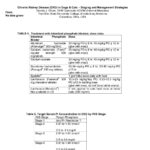
A Change To A Lower Phosphorus Diet
Initially, a diet change alone might be sufficient to keep your pet’ blood phosphorus level within normal limits. In the early experimental dog studies I mentioned, limiting phosphorus intake through a low-phosphorus diet appeared to increase lifespans. (read here) Minimizing phosphate/phosphorus intake appeared beneficial in rodent experiments as well. (read here) I suggest them when they appear to be helping.
Increased Water Intake = A Toxin Flush & A Combat Against Dehydration
Cats, in particular, rarely consume enough water. I believe that their natural diet of rodents, which are ~70% water, accounts for that. Regardless of what pet food companies want you to believe about their dry kibble, it’s designed for you, not your cat. Nature designed cats and dogs to eat meat and entrails, not dry, baked kibble composed of dehydrated waste from the human food chain and veggies. Nothing remotely resembling what you see on the bag is in the bag. (read here & here) Royal Canin’s dry kibble dog and cat foods are about 8% water, Purina One’s Cat Chow, a maximum of 12% water. Most dogs are better about drinking sufficient water to make up for that deficit that than are cats. But in either species, even mild intermittent dehydration is hard on their kidneys. Granted, feeding dry dog and cat foods is easier for us dog and cat owners. Less effort, less time, less hassle, less canned food odor, less halitosis, less cost. But when your beloved pet faces kidney issues, you ought to consider abandoning dry kibble for a more natural and hydrating diet. I just wish that the CEOs of those companies had to eat their products. It’s been done.
My choice is a diet that you prepare at home, from the things you eat, not some refrigerated or frozen, supposedly “fresh” product you pick up on the pet food isle or have shipped to your door by Amazon. If prepared at home correctly, the only addition needed is a calcium carbonate supplement. When industrially produced in bulk, there are too many unknown, and possibly unwashed fingers, too many robotic machines that can’t tell metal or plastic fragments from a piece of meat and too many supply line screwups that are possible. (read here), Sanitizing industrially produced “fresh” or frozen meat-containing pet food products with chemicals such as HMTBa or DBPs such as Clorox™, etc. are a less than ideal alternatives. (read here)
Hydra Care™
Purina recently introduced a new product, Hydra Care™, designed to encourage your cat to drink more. Please Let me know if it has helped your cat. I am particularly interested to know if Hydra Care™ decreased or stabilized your cat’s blood creatinine level. There is also some early evidence that drinking more water slows the progress of CKD in humans as well. (read here) Dogs, due to their different method of lapping, might not be helped as much by this product.
There are other things you can do to encourage your pet to drink more. Have multiple water sources located throughout your house. Like us, all pets have their idiosyncrasies. Some drink more from wider shallow bowels than narrow deeper ones. Some prefer bottled water over tap water. Some will drink more when their water is flavored – perhaps by an added ice cube of meat broth, tuna or clam juice. Some prefer a source of dripping water, others a fountain. Cats often prefer their water sources far from their litter boxes. When pets advance to the later stages of CKD (stage 3+) your veterinarian might suggest that you give extra fluid at home by subcutaneous injection. That is not as extreme as it sounds. But because of their serious kidney issues, these pets are susceptible to over-hydration from fluids given by injection. So, these fluids must be given slowly and not over-zealously. That is also why it is much safer to give fluids under your pet’s skin from where they are slowly absorbed rather than intravenously. Your veterinarian will suggest how much and how often. Their veterinary nurses should show you how it’s properly done.
Administering fluid this way is not the same thing as peritoneal dialysis. That is a technique in which your veterinarian injects balanced electrolyte fluids into the space surrounding your pet’s abdominal organs. After a period of time, your vet will attempt to remove as much of that fluid as possible – hoping that accumulated toxins have moved from your pet’s blood stream into the withdrawn fluid.
Don’t s
Always avoid situations that might lead to your cat or your dog becoming dehydrated. Stresses of all types should be avoided. Question the need for more vaccination boosters unless you and your pet have a highly unusual lifestyle. (read here and here)
Boarding pets that have developed CKD is unwise. Instead, hire an experienced pet sitter or ask a pet-savvy relative or neighbor. Multiple trips to your veterinarian’s office for subcutaneous fluid injections are also stressful for your pet and for you. As I mentioned, most pet owners learn to master subcutaneous fluid administration with a bit of instruction from one of your veterinarian’s nurses. There are also many videos on YouTube that will also help show you how it is properly done. I know we all have different talents and phobias; if you can’t bring yourself to give fluids unaided, there is usually a friend or someone in a local animal rescue group who would be happy to give you that extra support you need. Depending on legalities where you reside, veterinary nurses are quite capable of visiting your home to assist you.
Constipation is quite common in dehydrated or debilitated pets. They often need some help with that. Soupy foods rarely solve this problem without the aid of a mild laxative. Over the counter flavored, petrolatum-based cat constipation products are fine, if only given occasionally. But these products, when over-used, can result in poorer absorption of the fat soluble vitamins (A, D, E & K) as well as calcium. Miralax™ is effective in keeping stools soft enough so that they pass easier through the colon. Soluble fiber products such as BeneFiber™ or Miralax™ are another option. Lactulose not only softens stools, allowing them to pass more easily, but might also aid in reducing uremic toxins. (read here) Severe constipation requires your veterinarian’s intervention.
Maintaining Your Pet’s Acid To Base Balance
The bodies of pets facing kidney disease are always in danger of becoming too acidic. That situation is called metabolic acidosis. Normal cell metabolism = the everyday processes that all cells perform – create hydrogen ions, the source of an acidic body environment. We all rely on our kidneys to excrete those excess hydrogen ions and to create bicarbonate to keep our body’s acid:base in balance (a normal pH) within tight limits. (read here) Cats, and some dogs, with kidney problems can have problems maintaining their critical acid-to-base balance. In-office blood gas analyzers can detect the acidity of your pet’s blood. But these machines are more likely to be found in 24-hour emergency veterinary facilities than in the office of your neighborhood veterinarian. An increased anion gap is also a sign of too high body acidity. When an acid:base imbalance is detected, injectable or oral sodium bicarbonate is the most commonly used agent to correct it. The common name for sodium bicarbonate is baking soda.
Dealing With Poor Appetite, Nausea and Vomiting
I already mentioned (Entyce® or Elura®) appetite stimulants and mention them again later on. An almost universal occurrence in pets with advanced kidney disease is poor appetite. It probably occurs due to a large number of excesses and deficiencies that advanced kidney disease generates: the increased amount of uremic toxins are probably an important cause. So are the stomach and intestinal upsets that uremia encourages. Nausea might play a part too. The weakness and apathy of uremia-induced anemia can play a part as well. Whatever the causes, they are highly complex. (read here) Loss of lean muscle mass (protein-energy wasting aka PEW) is the strongest predictor of approaching mortality in dogs, cats and people. (read here & here) So we don’t want your cat or dog to lose lean weight. In pets and people, foods with pungent tastes and strong aromas are more likely to be eaten than bland foods.
There are a number of ways you can encourage your pet to eat:
As I mentioned, dogs and cats prefer the aroma, taste and texture of canned or freshly-prepared meaty foods over the aroma and texture of dry kibble. If you smell and taste kibble, you will know why. If your pet’s blood phosphorus level is already above normal, its favorite broth, soup or gravy, poured in moderate amounts over its main diet, are often sufficient to motivate its eating. Verbal encouragement and some stroking from you are very important too. Warmed diets are often preferred over cold ones. Smaller multiple meals often result in a daily food intake greater than just two or three. For cats, small amounts of high-aroma toppings (like sardines or clam juice) might do the trick. Avoid ingredients that contain flavor enhancers. (read here)
Entyce® & Elura®
The newest appetite stimulant on the market for pets is capromorelin. For dogs, it is Entyce®. For cats, it is marketed as Elura® Read dog owner’s experience with Entyce® here. Cat owner’s experience with Elura® here. Your feedback on its effects on your dog or cat with CKD or other health issues is appreciated.
There are also a number of medications veterinarians dispense in an attempt to improve your pet’s appetite other than Entyce® and Elura®. Mirtazapine is sometimes helpful. It is believed to reduce nausea as well. Doses in dogs and cats with kidney issues might need to be spaced farther apart. (read here) Mirtazapine is also sold as a transdermal (through the skin) ointment, Mirataz®, for cats
Cyproheptadine, an older antihistamine, also appears to stimulate some pets to eat.
PUFAs – Polyunsaturated Omega-3 Fatty Acids
Omega-3 fatty acid essential oils are mostly extracted from sea creatures. They are thought by many to reduce inflammation throughout the body. (read here) Many commercial kidney diets marketed for pets add PUFAs, as well as antioxidants like vitamin E, C and beta-carotene. One early study suggested that PUFAs were beneficial to dogs with experimental kidney failure. (read here) Another study contemplated their use in CKD in cats. (read here) Nothing of quality has been published regarding the usefulness of PUFAs in slowing the progression of CKD in humans or animals. But a study by a group of veterinarians in the Netherlands did find that cats fed a commercial diet with the highest PUFA level appeared to live the longest. (read here) The diets examined varied in many respects other than their PUFA content, but I am inclined to suggest a PUFA supplement for your pet – if given in reasonable amounts for its body weight. Perhaps it will be helpful. Just don’t get carried away. (read here) If you purchase a PUFA supplement, purchase one sold for human consumption from a trusted source. (read here) Quality control for products intended for human use tends to be better than those intended for use in pets.
Medications To Lower Confirmed High Blood Pressure
I mentioned that some dogs and cats with kidney disease have high blood pressure and how hard it is to for veterinarians to obtain accurate BP readings because of the anxiety factor. (read here & here) But in some pets it is real, and in those pets, the degree of blood pressure elevation and the degree of protein leakage into their urine seem to go hand in hand – at least in dogs. (read here & here) Most veterinarians believe that high blood pressure damages your pet’s kidneys. But it can be a two-way street. Kidney disease can also be the cause of high blood pressure through the renin-angiotensin axis. (read here & here) Giving medications that reduce high blood pressure is a first-line treatment for CKD in humans as well. (read here & here) The two groups of drugs that are commonly used in pets to lower blood pressure are ACE inhibitors such as enalapril or benazepril, or ARBs such as telmisartan(Semintra®) (read here) The actions of both groups relax and widen the diameter of blood vessels throughout the pet’s body, which enhances blood flow. As blood flow meets less resistance, your pet’s blood pressure should go down. That same effect is felt in your pet’s kidneys where pressure within the small, fragile blood filtering glomeruli is reduced. When giving any of these medications, your vet will be keeping his/her eye on your pet’s blood potassium level as well as its creatine level. (read here) Some veterinarians incorporate amlodipine – a drug that reduces blood pressure in a different manner. There is no agreement as to at what point any of these medications should be given or as to what an appropriate dose might be.
When Anemia Finally Arrives
As CKD progresses, it is common for pets to become anemic. By the time their packed cell volume (PCV) drops into the 20%s, their energy level, heart and breathing rate will be affected. (~stage 3-4). I mentioned earlier that the main cause of this anemia is insufficient kidney production of erythropoietin. At that stage, some veterinarians give their clients the option of opting for erythropoietin or darbepoetin injections – both of which stimulate the formation of red blood cells. Darbepoetin injections have the longer period of action – sometimes as long as two weeks. Both medications can take 3–4 weeks to improve your pet’s PVC or RBC numbers. A rather high number of pets have reactions to multiple injections of either product – but perhaps less with darbepoetin than erythropoietin. In one study, there were no significant differences in the life span of dogs that responded to darbepoetin treatment than those that did not. (read here) Many vets will check anemic pets for iron and/or folic acid deficiency. When present, hematinics are desirable. A blood transfusion is also possible. They are rarely suggested or performed. First off, it is quite stressful – the health of advanced CKD pets is already fragile. Secondly, there is the possibility of an immune reaction against the transfused blood. Thirdly, transfused red blood cells do not tend to live very long in uremic patients. Lastly, it is expensive. I do not recommend transfusions when the issue is CKD.
What About Hemodialysis Or A Kidney Transplant For My Pet?
Long-term hemodialysis is not readily available for dogs or cats. I am unsure why that is, since it is technically possible and potentially lucrative. When dialysis is performed, it is usually in a university setting and being performed experimentally or for sudden kidney injury or toxic exposure, in which case kidneys have a better chance for regeneration than they do in CKD. Pet dialysis treatments take 4–6 hours, 2–3 times a week. It would be a strain on both your pet and you. If your pet could talk, I do not think it would recommend it either.
There are also veterinary teaching hospitals that perform feline kidney transplants. Transplants are rarely performed on dogs because the current success rate is lower. Historically, the University of Pennsylvania School of Veterinary Medicine has the most experience performing them. (read here) Surgical technique and pre and post surgical care vary by institution. PennVet claimed a 60-70% one-year post-transplant feline survival rate as opposed to a 97% success rate in humans (cats being smaller are more difficult?). I believe that the most common complication, when one occurs, is scarring and inflammation that obstructs the passage of urine from the transplanted kidney (retroperitoneal fibrosis) (read here) Cats with concurrent health issues or advanced age are much poorer candidates. I do not know of any programs that currently accept dogs but could be unaware of some that do. Dogs tend to reject transplanted kidneys quite rapidly. They also suffer more infections, blood clots, etc. after the surgery than cats. Kidney transplants are not a cure – the animals must take anti-rejection medications for the rest of their lives (at a current cost of about $1,000+ per year + periodic testing). The bill for the surgery for one cat at PennVet in 2015 was $16,000, plus airfare, hotels, medical tests and follow-up appointments. With the owners hoping the final bill would not exceed $30,000. Vets in the UK view the ethics of this procedure differently and could not agree. Some found donor cats acceptable, others felt that only kidneys from cats that had died of other causes should be used. (read here)
On 4/4/24 PennVet’s estimated kidney transplant cost had increased to $24,000 – $27,000 for a “perfect, uncomplicated renal transplantation”. That includes, expected pre-op bloodwork, pre-op boarding, the surgery itself for your donor cat and the recipient cat, along with a week in their ICU. If either of the patients have unexpected complications, or concerns that lead their staff to require more bloodwork, imaging, longer hospitalization, etc., that is not included. They operate on a “who needs us most” basis, not a first come, first serve basis. That means that if a cat owner that inquires today needs them more urgently than someone who has been on their waiting list for over 2 years, today’s patient will be moved closer to the top of their list – if they passed their required initial testing requirements. Right now, for a patient not in dire need, and doing well on medical management, the time to review all records and coordinate with their different services takes about 4–6 weeks.
If you know current transplant costs, let me know.
How Much Longer Will My Cat Or My Dog Live?
The Animal Medical Center (AMC) in Manhattan, NY is the premier animal hospital in New York City. One of the best in the World. In 2008, they reviewed their data and outcomes on 211 cats With CKD. Health cats have a blood creatinine level of less than 0.6 mg/dL (53 µmol/L). Dogs, less than 0.5 mg/dL (44 µmol/L). When a cat first arrived with a fasting blood creatinine level of 2.4-2.8 mg/dL (µmol/L) its average survival time was 3.15 years. When a cat first arrived with a fasting blood creatine level of 2.9-5.0 mg/dL (251–440 µmol/L) its average survival time was 2.13 years. When a cat first arrived fasting blood creatinine exceeded 4 mg/dL or 354 µmol/L, their median survival time was 4.1 months. When a cat firsts arrived with a fasting blood creatinine level of greater than 5.0 mg/dL (442 µmol/L) its average survival time was about 3.5 months. The average survival time of cats that first arrived already seriously anemic was 3.3 months. The average survival time once a cat had begun to lose weight was just a bit over one year. The average survival time from the point where subcutaneous fluids were begun was 9 months. If you would like to read the full article ask me for Boyd2008. Similar data does not exist for dogs. What is considered “normal” creatinine varies between laboratories. (read here) In dogs, “normal”also varies between age, breed, sex and neuter status. (read here)
During that very early period of kidney decline, “wellness exams” and geriatric profiles give your veterinarian very little warning that something is brewing. Cut-off values for normal blood results are somewhat arbitrary. High-end normals can be just that – normal. They can also return to midline values the following day. But high-end “normal” values, particularly when they persist, can indicate the beginning of a problem. Few pet owners are going to repeat these tests every month to detect these trends. IRIS, the National Renal Interest Society, associates blood creatinine levels of 1.4 – 2.0 mg/dL for dogs and 1.6 – 2.8 for cats with this early period. The pet’s early morning urine might be a bit too dilute as well (=low urine specific gravity). I already mentioned Idexx’s patented SDMA test. Not to be outdone, Antech/Mars added their patented RenalTech® “kidney health” test to the list of tests that they offer. I have little faith in the ability of either test to predict the speed of your pet’s kidney decline.
The International Veterinary Renal Interest Society, IRIS, recommends considering “heroic” procedures for pets in stage 4 kidney failure: surgically implanted feeding tubes, surgical implanted stomach ports, multiple IVs, peritoneal dialysis and hospice care. I cannot imagine your dog or your cat wanting to be put through those miseries. Your pet loved you above all else for many years. The least you can do for your friend at this point in its life is to help send it peacefully to Heaven. You might not agree with me, but in my opinion, that is the only merciful thing to do.
You are on the Vetspace animal health website
Visiting the products that you see displayed on this website help pay the cost of keeping these articles on the Internet.



